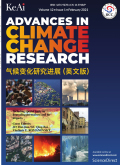首页|期刊导航|气候变化研究进展(英文版)|An assessment of the CMIP6 performance in simulating Arctic sea ice volume flux via Fram Strait
气候变化研究进展(英文版)2024,Vol.15Issue(4):584-595,12.DOI:10.1016/j.accre.2024.06.008
An assessment of the CMIP6 performance in simulating Arctic sea ice volume flux via Fram Strait
An assessment of the CMIP6 performance in simulating Arctic sea ice volume flux via Fram Strait
摘要
关键词
Sea ice volume flux/CMIP6 models/Fram Strait/Attribution analysisKey words
Sea ice volume flux/CMIP6 models/Fram Strait/Attribution analysis引用本文复制引用
Hui-Yan KUANG,Shao-Zhe SUN,Yu-Fang YE,Shao-Yin WANG,Hai-Bo BI,Zhuo-Qi CHEN,Xiao CHENG..An assessment of the CMIP6 performance in simulating Arctic sea ice volume flux via Fram Strait[J].气候变化研究进展(英文版),2024,15(4):584-595,12.基金项目
This study was supported by the National Natural Science Foundation of China(42106225),the Innovation Group Project of Southern Marine Science and Engineering Guangdong Lab-oratory(Zhuhai)(311021008),and the Natural Science Foun-dation of Guangdong Province,China(2022A1515011545). (42106225)

